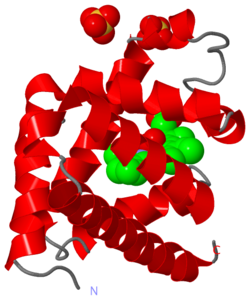JMS/sandbox15
From Proteopedia
Extraordinary Proteins. Extreme lifestyles sometimes require increasing the abundance of a protein with critical properties. We present the role charged amino acids - such as aspartic acid, glutamic acid, arginine, histidine and lysine - can have in changing a protein's solubility. Elephants can hold their breath for 2 minutes, but whales can hold their breath for 90 minutes - and they do, migrating underwater around the world. To find out how, a group of researchers contacted museums and zoos around the world[1]. They hypothesized that a vital element of whales and other aquatic animals' ability to hold their breath for so long is storage of more oxygen in their muscles by increasing the concentration of myoglobin, the protein that stores oxygen in muscle tissue. Specifically, they predicted that species could increase the concentration of myoglobin by increasing its solubility through increasing the number of positively charged regions on the protein's surface, so that even at high concentration the electrostatic repulsion between the myoglobin proteins would prevent their aggregation. Amazingly, they found an association between an animals' ability to hold its breath, higher concentrations of myoglobin in muscle tissue, and an increase in its net charge (taken as a proxy for an increase in the number of positively charged regions on the surface). Typically, purified terrestrial mammal's myoglobin has a solubility of 20 mg/g in an aqueous solution at neutral pH (Sigma Aldrich) which turns out to be the maximum level of myoglobin found in most terrestrial mammal's tissue. But whales and other aquatic mammals far exceed this solubility limit, e.g., whales have 70 mg/g. The way that they overcome the solubility constraint may be traced back to a modest increase in the net charge of myoglobin - from around +2 in terrestrial animals to around +4 in aquatic animals.[2] Molecular Tour: The ability of an increase in number of positively charged regions to enable higher solubility is a known phenomenon, and this study is consistent with previous reports. The aquatic animals have increased their number of positively charged regions through key substitutions of neutral amino acids for positively charged amino acids, and of negative amino acids for neutral or positive amino acids. We present one such manifestation of this overall trend, by comparing the elephant and whale myoglobin structures. Out of 27 divergent amino acids between whale and elephant's myoglobin - from a total of 153 amino acids - only 8 of these amino acids lead to changes of charge. These eight amino acids are shown for whales and elephants, . Arginine and Lysine have a charge of +1, aspartic and glutamic acids have charges of -1, and histidine in positions 12 and 116 have a charge of about +0.5 (supplementary Table S2 [1]). The whale amino acids, have an illustrative eletrostatic field drawn around the in the residue. Note that the effective size of the electric field of the charged atom at the end of residues like lysine is actually larger, because of the multiple conformations a long residue like lysine moves between. Next to the whale amino acid, the are shown in yellow halos and labelled with the residue name. From studying the differences between these two proteins, it is clear that the whale protein has more areas with a positive electrostatic field. These positive electrostatic fields are of the whale protein, and will repel any whale myoglobin, preventing the protein-protein interactions that lead to aggregation. Another way to say this, in the case of proteins , is that, for each and every protein, (e.g., lysine's ammonium at physiology pH has three hydrogens - not shown) coming off a positively charged atom, or associates with the charged atom itself, thus screening each protein from the other proteins. Still, this picture is incomplete. While illustrative of the basic principles of how small electrostatic fields changes can greatly increase a protein's solubility, there other contributing factors to the electrostatic field, e.g., solvated ions, crowding conditions, and the neighboring residues to these divergent residues. For example, when a negatively charged residue neigbors one of these additional positive residues, then from a distance relatively larger than the distance between the two oppositely charged residues, the electrostatic field is zero.
| |||||||||||
References:
- ↑ 1.0 1.1 Mirceta S, Signore AV, Burns JM, Cossins AR, Campbell KL, Berenbrink M. Evolution of mammalian diving capacity traced by myoglobin net surface charge. Science. 2013 Jun 14;340(6138):1234192. doi: 10.1126/science.1234192. PMID:23766330 doi:http://dx.doi.org/10.1126/science.1234192
- ↑ https://pdb101.rcsb.org/motm/1#:~:text=PDB%2D101%3A%20Molecule%20of%20the%20Month%3A%20Myoglobin.

